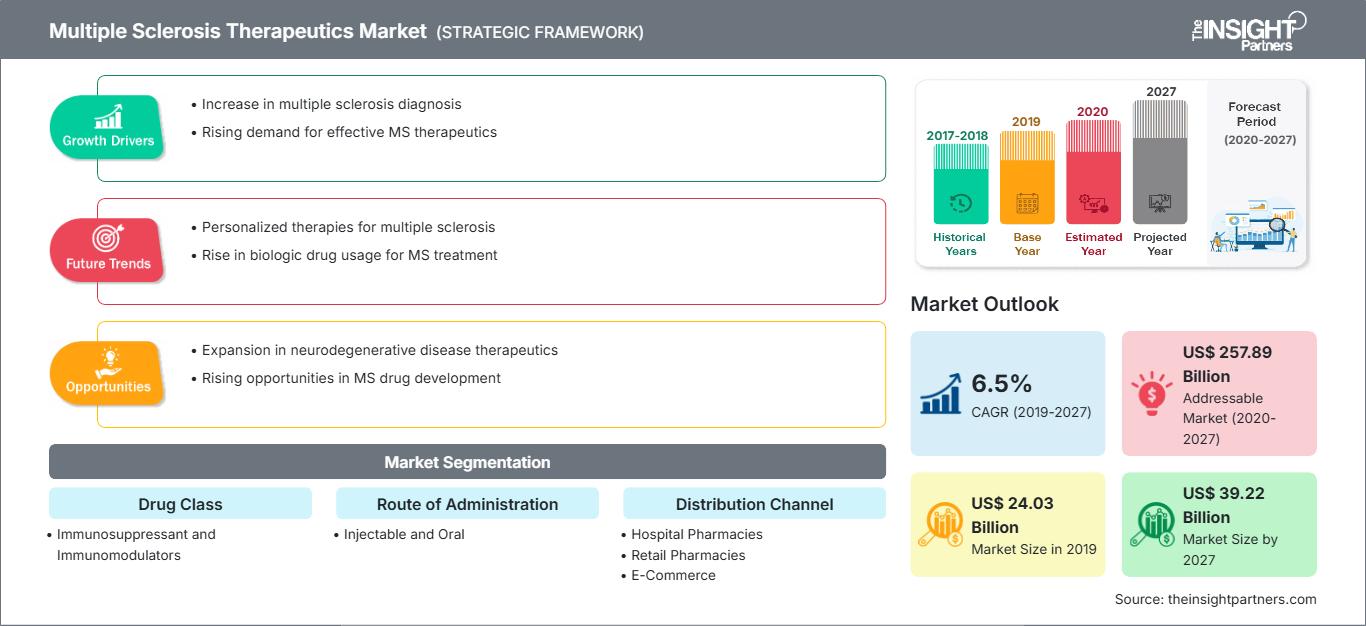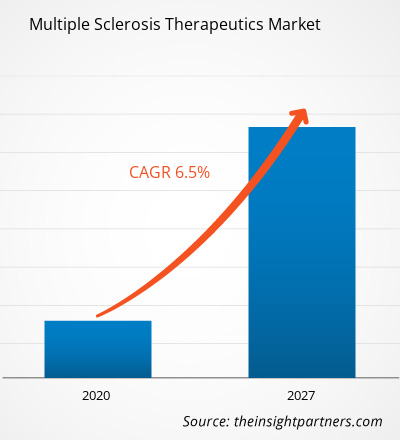Der Markt für Multiple-Sklerose-Therapeutika wurde 2019 auf 24.026,90 Millionen US-Dollar geschätzt und soll bis 2027 39.223,59 Millionen US-Dollar erreichen; von 2020 bis 2027 wird ein CAGR-Wachstum von 6,5 % erwartet.
Multiple Sklerose (MS) ist eine Autoimmunerkrankung des zentralen Nervensystems. Das Immunsystem greift die Nerven an, was zu Kommunikationsproblemen zwischen Gehirn und Rest des Körpers führt. Immunsuppressiva und Immunmodulatoren sowie Physiotherapie werden häufig zur Behandlung von MS eingesetzt.
Der Markt für Multiple-Sklerose-Therapeutika umfasst Medikamentenklasse, Verabreichungsweg, Vertriebskanal und Region. Der Markt für Multiple-Sklerose-Therapeutika wird anhand von Regionen wie Nordamerika, Europa, Asien-Pazifik, Naher Osten und Afrika sowie Süd- und Mittelamerika analysiert. Der Bericht bietet Einblicke und eine eingehende Analyse des Marktes für Multiple-Sklerose-Therapeutika und legt dabei den Schwerpunkt auf verschiedene Parameter wie Markttrends, technologische Fortschritte, Marktdynamik und eine Analyse der Wettbewerbslandschaft führender Marktteilnehmer weltweit.
Passen Sie diesen Bericht Ihren Anforderungen an
Sie erhalten kostenlos Anpassungen an jedem Bericht, einschließlich Teilen dieses Berichts oder einer Analyse auf Länderebene, eines Excel-Datenpakets sowie tolle Angebote und Rabatte für Start-ups und Universitäten.
Markt für Multiple-Sklerose-Therapeutika: Strategische Einblicke

-
Holen Sie sich die wichtigsten Markttrends aus diesem Bericht.Dieses KOSTENLOSE Beispiel umfasst Datenanalysen, die von Markttrends bis hin zu Schätzungen und Prognosen reichen.
Multiple Sklerose ist eine chronische Erkrankung, die das Gehirn, das Rückenmark und die Sehnerven betrifft. Zu den Symptomen von Multipler Sklerose gehören Schwäche, Angst, Geschmacksstörungen, verminderte Sinneswahrnehmung und verschwommenes Sehen oder Sehverlust. Weitere Anzeichen sind Verstopfung, Muskelsteifheit, Depression, Denkstörungen und Probleme beim Wasserlassen.
Studien deuten darauf hin, dass die Prävalenz von Multipler Sklerose weltweit zunimmt. Einer Studie der National Multiple Sclerosis Society aus dem Jahr 2017 zufolge lebten beispielsweise in den USA etwa 1 Million Erwachsene (bis zu 913.925) mit MS. Im Jahr 2010 lag die geschätzte Prävalenz der Krankheit bei 309 Fällen pro 100.000 Menschen, d. h., es litten 727.344 Erwachsene an MS. Darüber hinaus leben laut der kanadischen Regierung (Schätzungen von 2014–2015) über 77.000 Kanadier mit Multipler Sklerose, drei Viertel davon sind Frauen.
Darüber hinaus schätzte die Multiple Sclerosis Society, dass im Jahr 2018 in Großbritannien etwa 110.000 Menschen an dieser Krankheit litten. Sie erwähnte auch, dass MS bei Frauen mehr als doppelt so häufig auftritt wie bei Männern. Die Zahl der jährlich neu diagnostizierten Patienten steigt ebenfalls an; sie stieg von 5.000 im Jahr 2017 auf 6.700 im Jahr 2018.
Die zunehmende Prävalenz von Multipler Sklerose treibt daher den Markt für Multiple-Sklerose-Therapeutika an.
Einblicke auf Basis von Arzneimittelklassen
Basierend auf den Arzneimittelklassen der Multiple-Sklerose-Therapeutika ist der Markt für Multiple-Sklerose-Therapeutika in Immunsuppressiva und Immunmodulatoren unterteilt. Im Jahr 2019 hatte das Segment der Immunmodulatoren den größten Marktanteil. Das Wachstum dieses Segments ist auf die Einführung neuer Generika und die zunehmende Verwendung von Immunmodulatoren in der MS-Behandlung zurückzuführen. Das Segment der Immunsuppressiva wird im Prognosezeitraum voraussichtlich eine höhere durchschnittliche jährliche Wachstumsrate (CAGR) verzeichnen.
Einblicke in die Verabreichungswege
Der Markt für Multiple-Sklerose-Therapeutika ist hinsichtlich der Verabreichungswege in injizierbare und orale Präparate unterteilt. Das Segment der injizierbaren Präparate hatte 2019 den größten Marktanteil und wird im Prognosezeitraum voraussichtlich eine höhere durchschnittliche jährliche Wachstumsrate (CAGR) verzeichnen.
Einblicke in die Vertriebskanäle
Der Markt für Multiple-Sklerose-Therapeutika ist nach den Vertriebskanälen in Krankenhausapotheken, Einzelhandelsapotheken und E-Commerce unterteilt. Das Segment der Krankenhausapotheken hatte 2019 den größten Marktanteil und das Segment E-Commerce wird im Prognosezeitraum voraussichtlich die höchste durchschnittliche jährliche Wachstumsrate (CAGR) auf dem Markt verzeichnen.
Die COVID-19-Pandemie ist weltweit zur größten Herausforderung geworden. Diese Herausforderung wird insbesondere in Entwicklungsländern weltweit beängstigend sein, da sie aufgrund von Störungen im Welthandel zu einem Rückgang der Importe führen wird. Bis heute gibt es keine endgültige Behandlung gegen COVID-19. Patienten mit schweren Gesundheitsproblemen, beispielsweise neurologischen Erkrankungen und anderen, erleben Verzögerungen bei der Behandlung solcher chronischen Krankheiten. Unterbrechungen der Lieferkette im Zusammenhang mit dieser Pandemiesituation werden sich letztlich kurzfristig auf den Produktabsatz auswirken. Die Versorgung mit MS-Medikamenten war während der Pandemie jedoch ununterbrochen gewährleistet, da die Apotheken während des Lockdowns geöffnet bleiben durften. Als Reaktion auf die COVID-19-Pandemie schränken mehrere Unternehmen ihre klinischen Studien ein und verschieben Produkteinführungen. So verzögerte beispielsweise Bristol-Myers Squibb die Markteinführung seines Multiple-Sklerose-Medikaments Zeposia (Ozanimod) aufgrund des Ausbruchs der COVID-19-Pandemie.
Unternehmen verfolgen häufig Strategien zur Produkteinführung und Expansion, um ihre Präsenz weltweit auszubauen und die wachsende Nachfrage zu befriedigen. Diese Strategien werden von den Marktteilnehmern häufig verfolgt, um ihr Produktportfolio zu erweitern.
Die Marktteilnehmer auf dem Markt für Multiple-Sklerose-Therapeutika verfolgen die Strategie der Produktinnovation, um der sich weltweit ändernden Kundennachfrage gerecht zu werden und so ihren Markennamen weltweit zu behaupten.
Multiple-Sklerose-Therapeutika
Regionale Einblicke in den Markt für Multiple-Sklerose-TherapeutikaDie Analysten von The Insight Partners haben die regionalen Trends und Faktoren, die den Markt für Multiple-Sklerose-Therapeutika im Prognosezeitraum beeinflussen, ausführlich erläutert. In diesem Abschnitt werden auch die Marktsegmente und die geografische Lage von Multiple-Sklerose-Therapeutika in Nordamerika, Europa, im asiatisch-pazifischen Raum, im Nahen Osten und Afrika sowie in Süd- und Mittelamerika erörtert.
Umfang des Marktberichts zu Multiple-Sklerose-Therapeutika
| Berichtsattribut | Einzelheiten |
|---|---|
| Marktgröße in 2019 | US$ 24.03 Billion |
| Marktgröße nach 2027 | US$ 39.22 Billion |
| Globale CAGR (2019 - 2027) | 6.5% |
| Historische Daten | 2017-2018 |
| Prognosezeitraum | 2020-2027 |
| Abgedeckte Segmente |
By Arzneimittelklasse
|
| Abgedeckte Regionen und Länder |
Nordamerika
|
| Marktführer und wichtige Unternehmensprofile |
|
Dichte der Marktteilnehmer für Multiple-Sklerose-Therapeutika: Verständnis ihrer Auswirkungen auf die Geschäftsdynamik
Der Markt für Multiple-Sklerose-Therapeutika wächst rasant. Die steigende Nachfrage der Endverbraucher ist auf Faktoren wie veränderte Verbraucherpräferenzen, technologische Fortschritte und ein stärkeres Bewusstsein für die Produktvorteile zurückzuführen. Mit der steigenden Nachfrage erweitern Unternehmen ihr Angebot, entwickeln Innovationen, um den Bedürfnissen der Verbraucher gerecht zu werden, und nutzen neue Trends, was das Marktwachstum weiter ankurbelt.

- Holen Sie sich die Markt für Multiple-Sklerose-Therapeutika Übersicht der wichtigsten Akteure
- Immunsuppressiva
- Immunmodulatoren
Nach Verabreichungsweg
- Injizierbar
- Oral
Nach Vertriebskanal
- Krankenhausapotheken
- Einzelhandelsapotheken
- E-Commerce
Nach Geografie
- Nordamerika
- USA
- Kanada
- Mexiko
- Europa
- Frankreich
- Deutschland
- Italien
- Großbritannien
- Spanien
- Restliches Europa
- Asien-Pazifik (APAC)
- China
- Indien
- Süd Korea
- Japan
- Australien
- Restlicher Asien-Pazifik-Raum
- Naher Osten und Afrika (MEA)
- Südafrika
- Saudi-Arabien
- VAE
- Restlicher Naher Osten und Afrika
- Südamerika (SAM)
- Brasilien
- Argentinien
- Restliches Südamerika
Firmenprofile
- Merck & Co., Inc.
- Novartis AG
- Bayer AG
- Sanofi
- Bristol-Myers Squibb Company
- Horizon Therapeutics plc.
- TEVA PHARMACEUTICAL INDUSTRIES LTD
- Takeda Pharmaceutical Company Limited
- F. HOFFMANN-LA ROCHE LTD.
- Biogen
- Historische Analyse (2 Jahre), Basisjahr, Prognose (7 Jahre) mit CAGR
- PEST- und SWOT-Analyse
- Marktgröße Wert/Volumen – Global, Regional, Land
- Branchen- und Wettbewerbslandschaft
- Excel-Datensatz
Aktuelle Berichte
Erfahrungsberichte
Grund zum Kauf
- Fundierte Entscheidungsfindung
- Marktdynamik verstehen
- Wettbewerbsanalyse
- Kundeneinblicke
- Marktprognosen
- Risikominimierung
- Strategische Planung
- Investitionsbegründung
- Identifizierung neuer Märkte
- Verbesserung von Marketingstrategien
- Steigerung der Betriebseffizienz
- Anpassung an regulatorische Trends






















 Kostenlose Probe anfordern für - Markt für Multiple-Sklerose-Therapeutika
Kostenlose Probe anfordern für - Markt für Multiple-Sklerose-Therapeutika